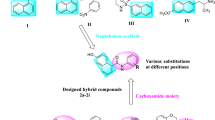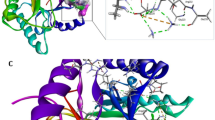Abstract
Echinocandin B deacylase (EBDA), from Actinoplanes utahensis ZJB-08196, is capable of cleaving the linoleoyl group from echinocandin B (ECB), forming the echinocandin B nucleus (ECBN), which is a key precursor of semisynthetic antifungal antibiotics. In the present study, molecular evolution of AuEBDA by random mutagenesis combined with site-directed mutagenesis (SDM) and screening was performed. Random mutagenesis on the wild-type (WT) AuEBDA generated two beneficial substitutions of G287Q, R527V. The “best” variant AuEBDA-G287Q/R527V was obtained by combining G287Q with R527V through SDM, which was most active at 35 °C, pH 7.5, with Km and vmax values of 0.68 mM and 395.26 U/mg, respectively. Mutation of G287Q/R527V markedly increased the catalytic efficiency kcat/Km by 290% compared with the WT-AuEBDA.




Similar content being viewed by others
References
Takeshima, H., Inokoshi, J., Takada, Y., Tanaka, H., & Ōmura, S. (1989). A deacylation enzyme for aculeacin A, a neutral lipopeptide antibiotic, from Actinoplanes utahensis: Purification and characterization. Journal of Biochemistry, 105(4), 606–610.
Kreuzman, A. J., Hodges, R. L., Swartling, J. R., Pohl, T. E., Ghag, S. K., Baker, P. J., McGilvray, D., & Yeh, W. K. (2000). Membrane-associated echinocandin B deacylase of Actinoplanes utahensis: purification, characterization, heterologous cloning and enzymatic deacylation reaction. Journal of Industrial Microbiology and Biotechnology, 24(3), 173–180.
Inokoshi, J., Takeshima, H., Ikeda, H., & Ōmura, S. (1993). Efficient production of aculeacin A acylase in recombinant Streptomyces strains. Applied Microbiology and Biotechnology, 39(4-5), 532–536.
Kim, Y., Kim, S., Earnest, T. N., & Hol, W. G. J. (2002). Precursor structure of cephalosporin acylase Insights into autoproteolytic activation in a new Nterminal hydrolase family. Journal of Biological Chemistry, 277(4), 2823–2829.
Shao, L., Li, J., Liu, A. J., Chang, Q., Lin, H. M., & Chen, D. J. (2013). Efficient bioconversion of echinocandin B to its nucleus by overexpression of deacylase genes in different host strains. Applied and Environmental Microbiology, 79(4), 1126–1133.
Zhao, L. N., Wang, Q. L., Bie, Y., & Lu, X. X. (2017). Isolation, identification and characterization of potential impurities of anidulafungin. Journal of Pharmaceutical and Biomedical Analysis, 141, 192–199.
Boeck, L. D., Fukuda, D. S., Abbott, B. J., & Debono, M. (1988). Deacylation of A21978C, an acidic lipopeptide antibiotic complex, by Actinoplanes utahensis. The Journal of Antibiotics, 41(8), 1085–1092.
Boeck, L. D., Fukuda, D. S., Abbott, B. J., & Debono, M. (1989). Deacylation of echinocandin B by Actinoplanes utahensis. The Journal of Antibiotics, 42(3), 382–388.
Yang, H., Swartz, A. M., Park, H. J., Srivastava, P., Ellis-Guardiola, K., Upp, D. M., Lee, G., Belsare, K., Gu, Y. F., Zhang, C., Moellering, R. E., & Lewis, J. C. (2018). Evolving artificial metalloenzymes via random mutagenesis. Nature Chemistry, 10(3), 318–324.
Matsuura, T., Miyai, K., Trakulnaleamsai, S., Yomo, T., Shima, Y., Miki, S., Yamamoto, K., & Urabe, I. (1999). Evolutionary molecular engineering by random elongation mutagenesis. Nature Biotechnology, 17, 58–61.
Shigehisa, M., Amaba, N., Arai, S., Higashi, C., Kawanabe, R., Matsunaga, A., Laksmi, F. A., Tokunaga, M., & Ishibashi, M. (2017). Stabilization of luciferase from Renilla reniformis using random mutations. Protein Engineering Design and Selection, 30(1), 7–13.
Kobayashi, R., Hirano, N., Kanaya, S., & Haruki, M. (2012). Enhancement of the enzymatic activity of Escherichia coli acetyl esterase by a double mutation obtained by random mutagenesis. Bioscience Biotechnology and Biochemistry, 76(11), 2082–2088.
Zhao, M., Wang, S. L., Tao, X. Y., Zhao, G. L., Ren, Y. H., Wang, F. Q., & Wei, D. Z. (2019). Engineering diverse eubacteria promoters for robust gene expression in Streptomyces lividans. Journal of Biotechnology, 289, 93–102.
Kim, M. S., & Lei, X. G. (2008). Enhancing thermostability of Escherichia coli phytase AppA2 by error-prone PCR. Applied Microbiology and Biotechnology, 79(1), 69–75.
Wang, Y. J., Liu, L. L., Wang, Y. S., Xue, Y. P., Zheng, Y. G., & Shen, Y. C. (2012). Actinoplanes utahensis ZJB-08196 fed-batch fermentation at elevated osmolality for enhancing acarbose production. Bioresource Technology, 103(1), 337–342.
Wang, Y. J., Zheng, Y. G., Xue, Y. P., Wang, Y. S., & Shen, Y. C. (2011). Analysis and determination of anti-diabetes drug acarbose and its structural analogs. Current Pharmaceutical Analysis, 7(1), 12–20.
Peimbert, M., & Segovia, L. (2003). Evolutionary engineering of a β-lactamase activity on a D-Ala D-Ala transpeptidase fold. Protein Engineering, 16(1), 27–35.
Chica, R. A., Doucet, N., & Pelletier, J. N. (2005). Semi-rational approaches to engineering enzyme activity: combining the benefits of directed evolution and rational design. Current Opinion in Biotechnology, 16(4), 378–384.
Ishibashi, M., Tatsuda, S., Izutsu, K. I., Kumeda, K., Arakawa, T., & Tokunaga, M. (2007). A single Gly114Arg mutation stabilizes the hexameric subunit assembly and changes the substrate specificity of halo-archaeal nucleoside diphosphate kinase. FEBS Letters, 581(21), 4073–4079.
Tsukada, S. I., Anzai, Y., Li, S., Kinoshita, K., Sherman, D. H., & Kato, F. (2010). Gene targeting for O-methyltransferase genes, mycE and mycF, on the chromosome of Micromonospora griseorubida producing mycinamicin with a disruption cassette containing the bacteriophage φC31 attB attachment site. FEMS Microbiology Letters, 304(2), 148–156.
Luo, Y., Wang, Y. S., Liu, J., Lan, H., Shao, M. H., Yu, Y., Quan, F. S., & Zhang, Y. (2015). Production of transgenic cattle highly expressing human serum albumin in milk by phiC31 integrase-mediated gene delivery. Transgenic Research, 24(5), 875–883.
Distler, J., Mansouri, K., & Piepersberg, W. (1985). Streptomycin biosynthesis in Streptomyces griseus II. Adjacent genomic location of biosynthetic genes and one of two streptomycin resistance genes. FEMS Microbiology Letters, 30(1–2), 151–154.
Xie, X. X., Shen, Q. C., Cao, L. S., Chen, Y. Y., Ma, L. Y., Xiao, Q. F., Yu, C. N., & Fu, Z. Z. (2019). Depression caused by long-term stress regulates premature aging and is possibly associated with disruption of circadian rhythms in mice. Physiology and Behavior, 199, 100–110.
Livak, K. J., & Schmittgen, T. D. (2001). Analysis of relative gene expression data using real-time quantitative PCR and the 2−ΔΔCTmethod. Methods, 25(4), 402–408.
Inokoshi, J., Takeshima, H., Ikeda, H., & Ōmura, S. (1992). Cloning and sequencing of the aculeacin A acylase-encoding gene from Actinoplanes utahensis and expression in Streptomyces lividans. Gene, 119(1), 29–35.
Yasutake, Y., Kusada, H., Ebuchi, T., Hanada, S., Kamagata, Y., Tamura, T., & Kimura, N. (2017). Bifunctional quorum-quenching and antibiotic-acylase MacQ forms a 170-kDa capsule-shaped molecule containing spacer polypeptides. Scientific Reports, 7(1), 8946.
Wang, Y. J., Ying, B. B., Shen, W., Zheng, R. C., & Zheng, Y. G. (2017). Rational design of Kluyveromyces marxianus ZJB14056 aldo–keto reductase KmAKR to enhance diastereoselectivity and activity. Enzyme and Microbial Technology, 107, 32–40.
Švedas, V. K., Margolin, A. L., & Berezin, I. V. (1980). Enzymatic synthesis of β-lactam antibiotics: A thermodynamic background. Enzyme and Microbial Technology, 2(2), 138–144.
Balasingham, K., Warburton, D., Dunnill, P., & Lilly, M. D. (1972). The isolation and kinetics of penicillin amidase from Escherichia coli. Biochimica et Biophysica Acta (BBA) – Enzymology, 276(1), 250–256.
Mahajan, P. B. (1984). Penicillin acylases. Applied Biochemistry and Biotechnology, 9(5), 537–554.
Funding
This work was financially supported by National Natural Science Foundation of China (21878274).
Author information
Authors and Affiliations
Corresponding author
Ethics declarations
This article does not contain any studies with human participants or animals performed by any of the authors.
Conflict of Interest
The authors declare that they have no conflict of interest.
Additional information
Publisher’s Note
Springer Nature remains neutral with regard to jurisdictional claims in published maps and institutional affiliations.
Rights and permissions
About this article
Cite this article
Cheng, YN., Qiu, S., Cheng, F. et al. Enhancing Catalytic Efficiency of an Actinoplanes utahensis Echinocandin B Deacylase through Random Mutagenesis and Site-Directed Mutagenesis. Appl Biochem Biotechnol 190, 1257–1270 (2020). https://doi.org/10.1007/s12010-019-03170-3
Received:
Accepted:
Published:
Issue Date:
DOI: https://doi.org/10.1007/s12010-019-03170-3




